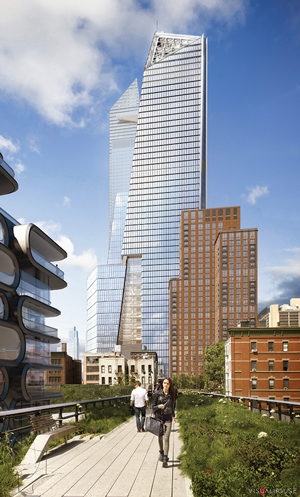Trending
The incredible shrinking office
More new buildings allow for packed workspaces, but will tenants start pushing the density limits?

In Hudson Yards, developers are testing the demand for large, super-dense office space. Two of Related Companies’ buildings in the Far West Side neighborhood have multiple floors that can provide each office worker less than 100 square feet of space, according to an analysis of floor sizes and allowable occupancy per floor, as designated by the city’s Department of Buildings. That is a level of density that brokers say few corporate cultures can tolerate.
The typical amount of space allocated in practice to each office worker has dwindled from approximately 300 to 400 square feet a decade ago to 125 to 250 square feet today, depending on the industry, according to insiders. But many believe the space allotted to individual workers has hit its nadir and that the long-term trend may even be reversing.
“People realized that if you put that many people into an open area you, need to give them other space,” said Bill Montana, a leasing broker at commercial firm Savills Studley [TRDataCustom], who noted that work areas have steadily decreased with the addition of telephone rooms and other common spaces.
“By the time you add those back in, your net square feet leased is about the same, but laid out differently,” he said.
Nonetheless, developers are delivering towers that allow tenants to squeeze more people into a given space. One of the floors at Related’s 10 Hudson Yards, occupied by designer Coach, can accommodate 739 office workers on a floor, which according to CoStar has 57,656 square feet. That would provide just 78 square feet per person. However, insiders say that it’s unlikely Coach would opt to make it that dense.
Meanwhile, the 14th floor of Related’s 30 Hudson Yards, which has been leased to Wells Fargo, allows for 615 people, or 89 square feet per person in the 55,500-square-foot space. Related did not respond to a request for comment.
The entire building can accommodate a staggering 21,722 workers, making it the largest building in terms of total possible occupancy filed with the DOB over the past 10 years, not including the towers at the World Trade Center site. (Those building plans are not filed with the city’s DOB, as part of an agreement with the Port Authority.)
CBRE’s Howard Fiddle, one of the agents leasing up space for Related at 30 Hudson Yards, did not expect the building’s tenants to butt up against the maximum occupancy. But he said tenants do factor capacity into their searches.
“The densification was hugely important,” he said, because some tenants need the flexibility to place many workers on a floor. Fiddle cautioned that “very rarely do they go denser than 100 [square feet per person].”

The Empire State Building
The Empire State Building, by way of historical example, allows for 16,410 office users spread across its 2.8 million-square- foot tower, with most floors providing 150 square feet or more per office worker, but tenants in that iconic building average more than 200 square feet per person, according to Anthony Malkin, CEO of the property’s owner, Empire State Realty Trust.
“We have found that our quality tenants occupy their spaces at lower densities than can be accommodated,” Malkin wrote in an email to The Real Deal.
Chris Helgesen, of Cushman & Wakefield, was incredulous that a firm would actually jam 600 people into a 55,500-square-foot space, as would be legally permissible at 30 Hudson Yards.
It’s worth noting that building for density is not a strictly new phenomenon: 55 Water Street, which was the city’s largest office tower when it was built in 1972, allows for densities as low as 87 feet per person on some floors, typically built for financial traders. But still that’s rare for Manhattan.
In addition, the U.S. lags far behind Asian countries — where businesses have crossed the 100-square-foot threshold — when it comes to pushing the limits on packing in employees.
Bloomberg LP, which was one of the first companies outside of financial traders to test the limits of close-quarter offices in New York City, has championed the benefits of tightly configured workspaces — and seating staff in an open “bullpen” environment.
“Part is how people work — they are more collaborative,” Fiddle said, describing the cultural shift that has unfolded over the last few decades. “Take 40 years ago. No one came close to one per 100. They would have said that’s insane.”




